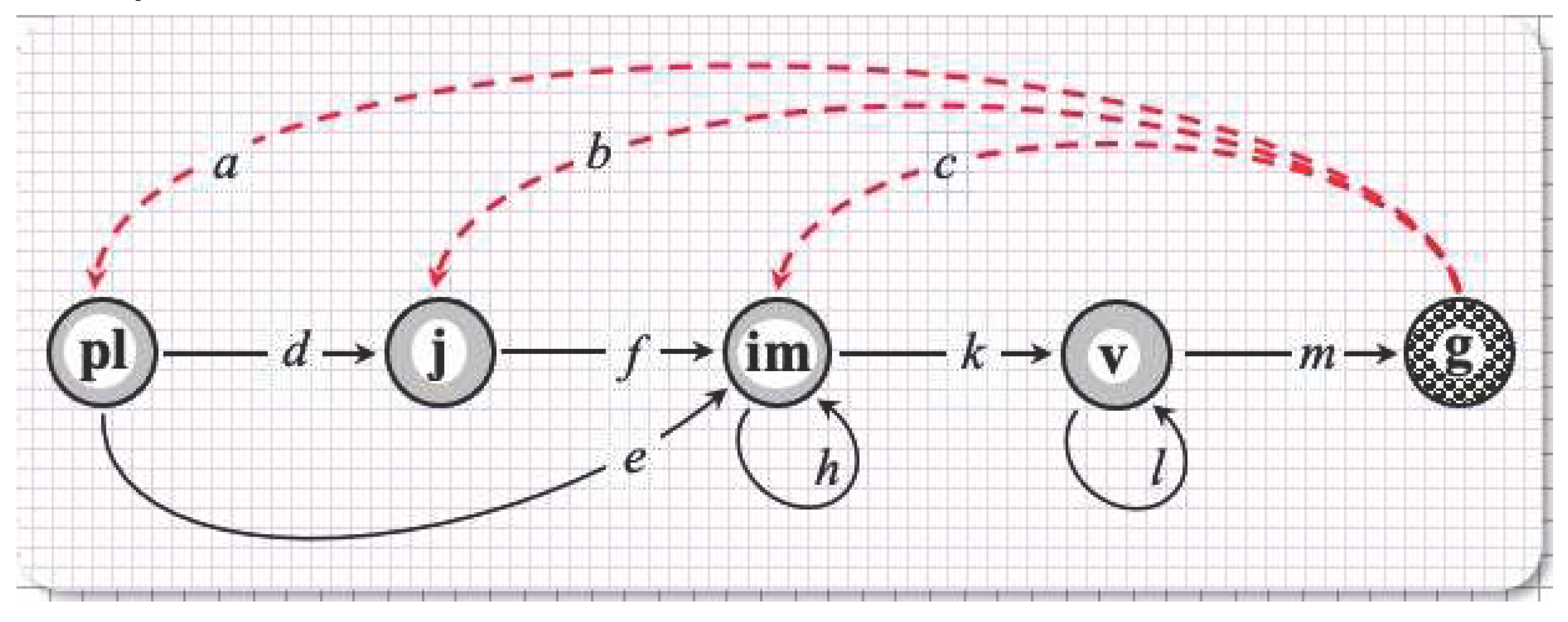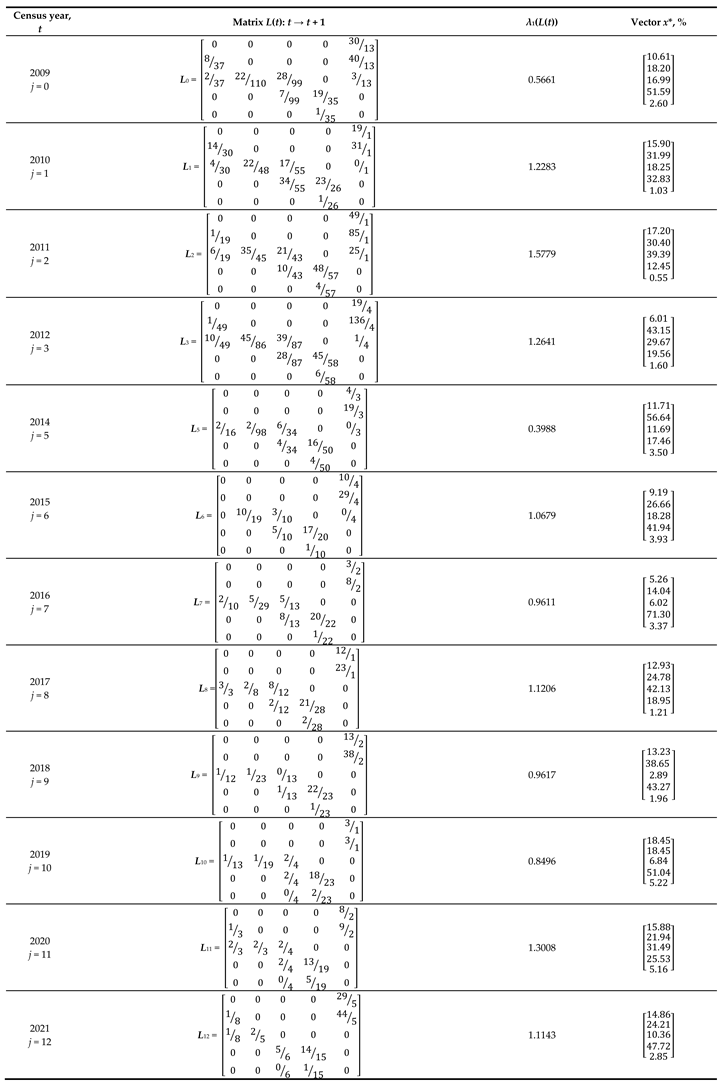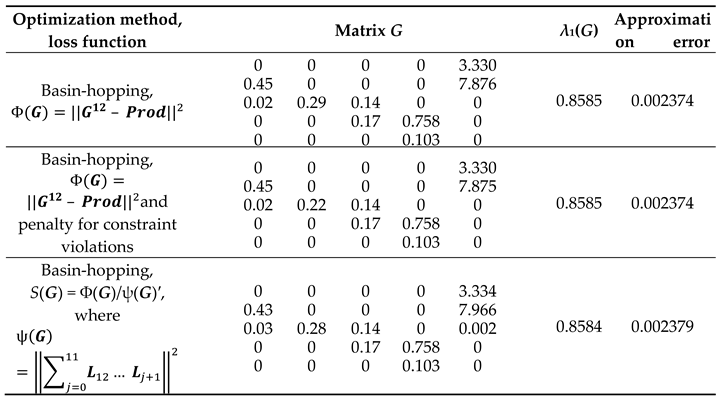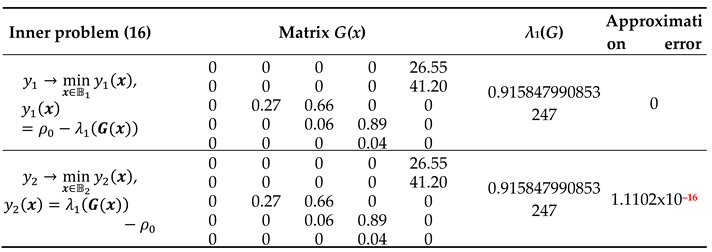1. Introduction
Pattern-multiplicative average (PMA) of nonnegative matrices is a concept motivated in the field of Matrix Population Models by the need to assess the viability of a local population from the outcome of its long-term monitoring. Matrix Population Models represent a wide and rapidly growing area of applications [CA23, CP23], where the theory of nonnegative matrices applies to population dynamics [BP94]. When biologists study a population of a plant or animal species and observe the population at discrete time moments, they classify individuals according to an observable trait such as age, body size, ontogenetic stage, etc., and divide the entire range of trait values into certain discrete classes, thus dealing with a discrete
population structure [Cas01]. It is expressed mathematically as a vector
x(
t) ϵ
(
n ≥ 2) representing the (absolute or relative) abundances of
n class-specific groups of individuals, whereafter the Matrix Population Model is a system of first-order difference equations,
linking the population vector at the next moment,
t + 1, to that at the current one,
t.
Matrix L(t) is therefore called the population projection matrix (PPM) [Cas01], despite the projection term has quite another meaning in matrix algebra [HoJ90]. All the matrix entries are nonnegative and called vital rates as they have certain demographic sense [Cas01]. The pattern of how zero/nonzero elements are arranged within the matrix is associated, in a unique way, to what is called the life cycle graph (ibidem) as it bears the biological knowledge of how the individuals grow/develop for one time step and provide for the population recruitment.
Being nonnegative, the PPM becomes a legal target for the Perron–Frobenius Theorem [Gan59, HoJ90], whereby a rich repertoire of model properties and population characteristics can be obtained after the PPM having been calibrated from data [Cas01, LSG21]. In particular, the dominant eigenvalue, λ1 > 0, of matrix L(t) serves as a “measure of how the local population is adapted to the environment where and when the data have been mined to calibrate the PPM” [L19] (p.1). When the data are of the ‘identified individuals’ type [Cas01], a great advantage of MPMs is that the calibration can be done just from two successive observations, thus meeting Eq.(1) and yielding a time-dependent L(t). Correspondingly, the adaptation measure, λ1, inherits the time dependence, and the great advantage turns dialectically into a great trouble or challenge when the task is to assess the adaptation from a time series of observation data, hence from a finite set of one-step PPMs.
The historically first response to the challenge was grounded on the theory of random sequences of vectors
L(
t)
x(
t),
t → ∞ [Co79, TuO80, Tu86, Tu90], and it has led to what is now called
the stochastic growth rate of a population in a randomly changing environment (see [Cas01] and refs therein). Another, more recent approach reverts the task just to averaging a given number, say
M (
M ≥ 2), of one-step PPMs and calculating the dominant eigenvalue,
λ1(
G), of the average matrix
G. Letter “G” here bears a hint to the
geometric (or
multiplicative) nature of averaging, and the hint will be revealed further in
Section 2.2. This approach has led to a concept that was proposed 5 years ago with regard to matrix population models [L18], and the task of averaging was reduced to a constrained nonlinear minimization problem for the matrix norm [L19, L18] (see
Section 2.3). The norm has however not appeared quite fit for global optimization, but required versatile optimization tools [PZL22] to solve the problem.
This paper aims at expanding those “versatile optimization tools” with another target of optimization, namely, the deviation of
λ1(
Gopt) from the ideal calculable
λ1(
G) (
Section 2.4). The approach originates from the fact the ideal
λ1(
G) is known:
where
Prod denotes the product of
M one-step PPMs. This leads to a problem that appears to be formalizable as a standard problem of linear programming (LP), hence solvable by standard routines. The solution is exemplified by a case study of monitoring a local population of an alpine short-lived perennial for 13 years [Let23] (
Section 2.1). Sections 2.3 and 2.4 contain respectively a short presentation of the published “versatile optimization tools” and an in-depth one of the original LP approach. The outcomes of the both are presented in
Section 3, enabling the comparison of results, which reveals a surprising contrast and induces some comments (
Section 4), in particular, on how general the proposed LP technique might be.
contains some ensuing conclusions.
2. Materials and Methods
2.1. Case Study
A local population of
Androsace albana, an alpine short-lived perennial plant species, was monitored on permanent sample plots once a year [Let23] during 14 years (2009–2022). Although
A. albana reproduces actually by seeds, the stage of dormant seeds was deliberately excluded from the life cycle graph by ontogenetic stages as the seed-related vital rates cannot be reliably estimated in the field [LKBO18]. Later on, we proved such an exclusion to be correct within the integer-valued formalism [LKO20], which can always be applied for the ‘identified individuals’ data. The life cycle graph looks correspondingly as shown in
Figure 1, with the “virtual” rather than real recruitment arcs. These three arcs ingo respectively to three early stages since the newly recruited plants can be observed in any of them at the moment of observation.
Now, we have
x(
t) ϵ
, and the natural order of components in
x(
t) leads to the following PPM
pattern:
with 10 vital rates to be calibrated. The calibration for 13 successive pairs of observation years results in 13
annual PPMs,
L(
t) = [
lij(
t)], presented in
Table 1. Each of them obeys Eq. (1). There are 6 annual PPMs with
λ1(
L(
t)) > 1 and 7 of those with
λ1(
L(
t)) < 1, so that even an “educated guess” of what should be
λ1(
G), the dominant eigenvalue of the average matrix, remains uncertain.
2.2. Pattern-Multiplicative Average of Annual PPMs
The logic of PMA ensues from the following apparent observation: given the 13 annual PPMs calibrated according to Eq. (1) (
Table 1), we have the initial population structure projected to the terminal one,
by
the product of 13 annual PPMS in the chronological order.
Since the average matrix ought to do absolutely the same when raised to the 13th power, we have the following
basic equation of averaging:
which justifies Eq. (2) of the Introduction. As is noted
ibidem, a routine extraction of the 13th root from a given, even positive,
Prod can hardly return a nonnegative matrix, nor guarantee the fixed pattern (3) for the root.
A workaround leads to solving matrix equation (6) as a system of scalar polynomial equations for unknown matrix elements. In fact, there are 5×5 – 10 = 15 elements that are prescribed to be zero by pattern (3), while the corresponding 15 scalar equations bind the unknown elements too, in addition to the 10 equations for the 10 unknowns. It means that Eq. (6) is overdetermined as a system of scalar equations, hence it may have an exact solution only under special relations between the equations depriving those extra 15 ones of their independence. No reason however to seek this kind of relation among the PPMs, so that Eq. (6), the basic equation of averaging has no solution over the set of pattern (3) PPMs.
The simple and clear logic of PPM averaging thus faces a principal obstacle in matrix algebra, and a workaround comes to an approximate solution.
2.3. Approximate PMA as a Nonlinear Constraned Minimization Problem
Any approximation invokes the question of how close is the approximate solution to the exact one. Although the latter is unknown, the equivalent form of Eq, (6):
just illustrates the ideal, yet unreachable, closeness as a 5×5 matrix of zeros. Retaining the same notation
G = [
gij] for the approximate average matrix, we can see the elements of
G13 as certain polynomials of the 5×13 = 65th degree. If we consider the quality of approximation to be a scalar value, then it should be the
error of approximation. The error can be measured as the (squared) matrix norm, whereby we come to the following
nonlinear minimization problem:
Here
defines the problem to be a
constrained one as it represents the constraints that ensue from the logics of averaging: the average vital rates should not be less, nor greater than those fixed in observations. In matrix terms, it means that each entry of the annual PPM has to lay within the bounds defined by the minimal value and the maximal one among the 13 annual values of that entry. In formal terms,
(see
Table 2).
So, we come to the constrained nonlinear minimization problem (8–9), where the bounds
of B are defined in
Table 2. Both standard routines for global optimization [MW23G] and more sophisticated ones [PZL22] can be applied for solving problem (8–9).
2.4. Approximate PMA as an Eigenvalue Constrained Optimization Problem
Noted in the Introduction, expression (2) is actually a simple algebraic consequence of (6), the basic equation of averaging, that would be true if the exact solution existed. Since it does not exist, another measure of approximation quality can be found by the following speculations.
Suppose
v to be a dominant eigenvector of the average matrix
G, i.e., we have
Acting by operator G successively on the both sides of Eq. (10), we get
(G)2 v = λ1(G)2 v,
(G)3 v = λ1(G)3 v,
In combination with the averaging Eq.(6), Eq.(11) signifies that
v is a dominant eigenvector of the matrix product,
Prod, too. Hereby, the other measure of approximation error is
can be calculated from the data presented in
Table 1. The optimal solution should be searched for among those matrices
G that has the same eigenvector
v. To exemplify how matrices of a single pattern with different eigenvalues may have the same dominant eigenvector is a student level exercise (A
hint to solution in
Appendix A).
To be unique, this eigenvector,
v*, can, for instance, be expressed in percent and calculated like the vectors
x* presented in
Table 1. It can thereafter serve as a constraint in the search of approximation among various
λ1 values associated with a single
v*. (To give an example of matrix eigenvalue being nonlinear as a function of matrix elements is another exercise.) Hence, we have a nonlinear minimization problem again. However, the
change of variables, a beloved mathematical trick,
turns the problem into a linear one. More specifically, it turns the task into the following two linear problems: to maximize the
λ1(G) when
ρ0 ≥
λ1(G) and to minimize it when
λ1(G) ≥
ρ0.
Moreover, vector
v* = [
v1,
v2, …,
v5], the known positive eigenvector of
G, and its dominant eigenvalue
λ1(G) are bound by definition to the matrix equation
With due regard to the fixed pattern (3) and with omitting subscript 1 at
λ1, this matrix equation reduces to the five scalar linear equations for
a,
b, …,
l,
m,
λ, the ten unknown entries of
G and the 11th formal variable
λ:
The 11th variable has its own bounds: as the dominant eigenvalue of the average matrix, the unknown
λ has to locate within the following bounds:
to be determined from
Table 1. The two specific problems specify these bounds further:
Finally, we have the following problem formulation:
where
x = [
a,
b, …,
l,
m,
λ]
T, while the polygons
(
p = 1, 2) are defined in (15) and the equality-type constraints (14). The two inner problems (16) represent the standard LP ones to be solved by standard software routines, such as function
linprog in MATLAB
® [MW23L] (technical details in
Appendix B).
3. Results
3.1. Case Study Outcome
Calibrated with the absolute accuracy, 13 annual PPMs for
A. albana are presented in
Table 1 with their dominant eigenvalues and corresponding eigenvectors.
3.2. Pattern-Multiplicative Averaging as an Approxiation Problem
The logics of approximate PMA have been implemented as problem settings in
Subsections 2.3 and
2.4. Matrix
Prod (4), the product of 13 annual PPMs, is too cumbersome to be presented here in its original rational form. Its numerical form up to the 15th significant digit is shown in
Table 3 together with the dominant eigenvalue and the corresponding eigenvector.
3.3. Minimizing the Approximation Error as a Matrix Norm.
Solution to the constraint minimization problem (8) has been obtained in [PZL22] by the “versatile optimization tools” (
Table 4) for the case of 12 annual PPMs. The quality of approximation ranges from 0.002374 to 0.002379 as a function of the optimization method (
ibidem). In the format of
Table 1, the obtained average matrices are presented in
Table 4.
3.4. Eigenvalue Constrained Optimization Problem
Solutions to the problem (14–16) are shown in
Table 5.
The solutions to the two optimization problems look indistinguishable within the publication format allowed, and they are really different at the 16th decimal digit alone, which may well be attributed to the computer round-off errors. It means that both problems have the same unique optimal solution, i.e., the corresponding vertex is in common of the polygons B1 and B 2.
4. Discussion and Conclusions
The case study practice has not motivated any logics of PMA beyond the population structure projection from the initial vector to the terminal one, i.e., Eqs. (4-5). Therefore, we deal here with
single-objective problems alone (in the terminology of [DRH21]). Once having been formulated in mathematical terms [L18], this objective comes immediately to the difference norm as the distance between two matrices following the fundamental of real analysis [K22]. However, even the squared matrix norm has required “versatile optimization tools” [PZL22] to achieve even moderate approximation quality in the corresponding nonlinear constrained minimization problem (
Table 4).
Beside of the moderate approximation quality, the basin-hopping global search, as an essential part of the “versatile optimization tools”, leaves no chance for the results being quantitatively reproducible as it is essentially stochastic [RC04]. In contrast, the LP approach is essentially deterministic [Lu73], hence the results of
Section 3.4 can be reproduced any number of times.
What does not contrast the LP approach to the PMA task is the eigenvalue optimization problem being nonlinear, too. Since the matrix eigenvalue in general and the dominant eigenvalue in particular is not linear as a function of matrix elements (see
Appendix A), the use of linear programming seems paradoxical at the first glance. However, beside of the trick with change of variables (11), the very nature of eigenvalue–eigenvector relations is linear, resulting in the linear relationships among matrix elements and the linear equality-type constraints in the LP setting. The trick has nevertheless failed to cheat a software routine formality, namely, to express the loss function as a linear combination of formal variables at fixed coefficients (see
Appendix B). The reason is quite evident: function (11) is not a linear function, albeit consisting of two linear parts.
These two parts have logically resulted in the two adjacent LP problems differing in the range (15) of the lambda alone. The both yield a single solution surprisingly coincident with the ideal
λ1(
G) (
Table 5). On the one hand, the theory of linear programming is known to admit nonunique solutions [Lu73]. On the other, different matrices might well have the same dominant eigenvector (see
Appendix A) in our practical case, too. Fortunately, the solution returned by the routine has turned out unique, hence the unique best solution to the averaging problem.
Moreover, this best solution is absolutely accurate (
Table 5), thus turning a solution to the approximate PMA problem into the exact one and suggesting the best alternative to our former ecological practice [L19, Let23, LKBO18]. Therefore, it makes no sense to quantitatively compare the outcomes of the “versatile optimization tools” and the LP approach – the comparison should rather be qualitative, with an obvious conclusion.
this best solution is absolutely accurate (
Table 5), thus turning a solution to the approximate PMA problem into the exact one and suggesting the best alternative to our former ecological practice [L19, Let23, LKBO18]. Therefore, it makes no sense to quantitatively compare the outcomes of the “versatile optimization tools” and the LP approach – the comparison should rather be qualitative, with an obvious conclusion, thus denying any possible reproaches to comparing the case of 12 annual PPMs [PZL22] with the current case of 13 PPMs.
The only “spoon of tar” in this “barrel of honey” is due to certain zeros in the optimal solution, i.e., zero entries to the average matrix
G. While there are totally 4 vital rates that have zero minimal values among the 13 annual ones (
Table 2), three of them, namely, for
c,
d, e, (
Figure 1), are reached by the “ideal” solution (
Table 5). The shares of
c = 0,
d = 0, and
d = 0, in the set of 13 annual PPMs (
Table 1) are equal respectively to 9/13, 7/14 and 1/13 (Appendix C). Whether the average matrix should take into account the most frequent zeros or all of them is a dialectical issue. The paradigm of biological diversity in general and the concept of
polyvariant ontogeny [Zh86,95] in particular dictate retaining all the links in the life cycle graph (Figure1), hence the absence of occasional zeros in the average matrix.
Therefore, an optimistic mathematical hypothesis is that the same absolute result can be obtained in the eigenvalue constrained optimization problem when we substitute the minimal positive bounds for the zero ones. Testing this hypothesis might be an object of further studies.
Note also that the LP technique presented in
Section 2.4 for a specific case study is general enough to be applied for any finite set of irreducible nonnegative fixed-pattern matrices, the specificity being only confined to the bounds and equality-type constraints. While the task is always to find the best approximation, a supertask is to motivate younger mathematicians for giving a theoretical explanation of why the best approximation turns into the exact solution.
Funding
This research was supported by the Russian Scientific Foundation, grant number 22–24–00628.
Acknowledgments
Author thanks Vladimir Yu. Protasov for the idea to formulate the PMA task as an LP problem. Programming and calculations were implemented in MATLAB® R2021b.
Conflicts of Interest
The author declares no conflict of interest with himself. The funder had no role in the design of the study; in the collection, analyses, or interpretation of data; in the writing of the manuscript; or in the decision to publish the results.
Appendix A
Exercise 1. Exemplify how matrices with a fixed pattern and different eigenvalues may have the same dominant eigenvector.
Hint: Consider an imprimitive Leslie matrix with the pattern of
and double it.
Exercise 2. Exemplify the matrix eigenvalue being nonlinear as a function of matrix elements. Hint: See matrix (A1).
Appendix B
Using MATLAB
®, we have logically to reformulate the LP problem in matrix terms and in the terms of problem (14–16). The corresponding solver
linprog [MW23L] finds the minimum in a problem specified by
Here vectors
are defined as
matrix
A and vector
b represent the inequality-type constraints (empty in our case),
Aeq and
beq the equality-type constraints:
vectors
lb and
ub, the lower and upper bounds respectively for
x, are given in
Table 2 lacking them for the last component
λ. Extracted from
Table 1, these bounds for
λ1(
G) are
Specified in accordance with (15), these bounds split to
where
ρ0 is given in
Table 3. Correspondingly, the pair of
lb and
ub split to the following ones:
where
Following (B1–B6) and the syntax of
linprog [MW23L], we input the following two calls:
which return what is shown in
Table 5.
Appendix С
To determine how many zeros are there among particular entries into a fixed place, say (3, 5), at all the 13 given matrices, we first arrange them as a 3D MATLAB® array [MW23D] All13L. Second, we calculate the frequency of zeros at that place by means of the built-in MATLAB® function nnz [MW23N] and the following line:
>> sym(13 - nnz(All13L(3, 5, :)))/13,
ans = 9/13.
Similar lines for the places of (2, 1) and (3, 1) return respectively 7/13 and 1/13.
References
- CA23 COMADRE, https://compadre-db.org/Data/Comadre (accessed on 30 05 2023).
- CP23 COMPADRE, https://compadre-db.org/Data/Compadre (accessed on 30 05 2023).
- BP94 Berman, A.; Plemmons, R.J. Nonnegative Matrices in the Mathematical Sciences. Philadelphia, Pennsylvania, USA.: Society for Industrial and Applied Mathematics, 1994.
- Cas01 Caswell, H. Matrix Population Models: Construction, Analysis and Interpretation, 2nd ed. Sinauer Associates: Sunderland, Mass., USA., 2001.
- HoJ90 Horn, R. A.; Johnson, C. R. Matrix Analysis; Cambridge University Press: Cambridge, 1990.
- Gan59 Gantmacher, F.R.. Matrix Theory; Chelsea Publ.: New York, NY, 1959.
- LSG21 Logofet, D.O.; Salguero-Gómez, R. Novel challenges and opportunities in the theory and practice of matrix population modelling: An editorial for the special feature “Theory and Practice in Matrix Population Modelling”. Ecological Modelling, 2021, 443, 109457. [CrossRef]
- L19 Logofet, D.O. Does averaging overestimate or underestimate population growth? It depends. Ecological Modelling, 2019, 411, 108744. [CrossRef]
- L18 Logofet, D.O. Averaging the population projection matrices: heuristics against uncertainty and nonexistence. Ecol. Complexity, 2018, 33(1), 66–74. [CrossRef]
- PZL22 Protasov, V.Yu.; Zaitseva, T.I.; Logofet, D.O. Pattern-multiplicative average of nonnegative matrices: When a constrained minimization problem requires versatile optimization tools. Mathematics, 2022, 10, 4417. [CrossRef]
- Co79 Cohen, J.E. Comparative statics and stochastic dynamics of age-structured populations Theor. Popul. Biol., 1979, 16 (2), 159–171. [CrossRef]
- TuO80, Tuljapurkar, S.D.; Orzack, S.H. Population dynamics in variable environments I. Long-run growth rates and extinction. Theor. Popul. Biol., 1980, 18 (3), 314–342. [CrossRef]
- Tu86. Tuljapurkar, S.D. Demography in stochastic environments. II. Growth and convergence rates. J. Math.Biol. 1986, 24, 569–581. [CrossRef]
- Tu90 Tuljapurkar, S.D. Population Dynamics in Variable Environments. Springer, Berlin, (Lecture Notes in Biomathematics, 85). [CrossRef]
- MW23G MathWorks, Documentation, https://www.mathworks.com/help/gads/globalsearch.html?s_tid=doc_ta (accessed on 30 05 2023).
- Let23 Logofet, D.O.; Golubyatnikov, L.L.; Kazantseva, E. S.; Belova, I.N., and Ulanova, N.G. Thirteen years of monitoring an alpine short-lived perennial: Novel methods disprove the former assessment of population viability. Ecol. Model., 2023, 477, 110208. [CrossRef]
- McD14 McDonald, J.J; Paparella, P.; Tsatsomeros, M.J. Matrix roots of eventually positive matrices. Linear Algebra and its Applications, 2014, 426, 122–137. [CrossRef]
- Aet04 Ando, T.; Li, C.-K.; Mathias, R. Geometric means. Linear Algebra Appl., 2004, 385, 305–334. [CrossRef]
- BH06 Bhatia, R.; Holbrook, J. Noncommutative geometric means. Math. Intell., 2006, 28 (1), 32–39. [CrossRef]
- dAr10 De Abreu, B.; Raydan, M. Residual methods for the large-scale matrix pth root and some related problems. Applied Mathematics and Computation, 2010, 217 (2), 650–660. [CrossRef]
- PP15 Politi, T.; Popolizio, M. On stochasticity preserving methods for the computation of the matrix pth root. Math. Comput. Simul., 2015, 100, 53–68. [CrossRef]
- Gu22 Guerry, M.-A. Algorithms for the matrix pth root. Special Matrices, 2022, . [CrossRef]
- Bi05 Bini, D. A.; Higham, N. J.; Meini, B. Algorithms for the matrix pth root. Numerical Algorithms, 2005, 39, 349–378. [CrossRef]
- LKBO18 Logofet, D.O.; Kazantseva, E.S.; Belova, I.N.; Onipchenko, V.G. How long does a short-lived perennial live? A modelling approach. Biol. Bul. Rev. 2018, 8 (5), 406–420.
- LKO20 Logofet, D.O.; Kazantseva, E.S., and Onipchenko, V.G. Seed bank as a persistent problem in matrix population models: from uncertainty to certain bounds. Ecol. Modell., 2020, 438, 109284. [CrossRef]
- Lu73 Luenberger, D. G. Introduction to Linear and Non-linear Programming, Reading, MA: Addison-Wesley, 1973.
- Zh86 Zhukova, L.A. Polyvariance of the meadow plants, in Zhiznennye formy v ekologii i sistematike rastenii (Life Forms in Plant Ecology and Systematics); Mosk. Gos. Pedagog. Inst.: Moscow, Russia, 1986; pp. 104–114.
- Zh95 Zhukova, L.A. Populyatsionnaya zhizn’ lugovykh rastenii (Population Life of Meadow Plants); Lanar: Yoshkar-Ola, Russia, 1995.
- MW23L MathWorks, Documentation, https://www.mathworks.com/help/optim/ug/linprog.html?s_tid=doc_ta (accessed on 30 05 2023).
- DRH21 Deb, K.; Roy, P.C.; Hussein, R. Surrogate modeling approaches for multiobjective optimization: Methods, taxonomy, and results. Math. Comput. Appl. 2021, 26(1), 5; [CrossRef]
- K22 Krantz, S.G. Real Analysis and Foundations, 5th ed.; Chapman & Hall: Publisher Location, 2022; pp. 325–413.
- RC04 Robert, C. P.; Casella, G. Monte Carlo Statistical Methods, 2nd ed. Springer, 2004. http://dx.doi.org/10.1007/978-1-4757-4145-2.
- MW23M MathWorks, Documentation, https://www.mathworks.com/help/matlab/math/multidimensional-arrays.html (accessed on 30 05 2023).
- MW23N MathWorks, Documentation, https://www.mathworks.com/help/matlab/ref/nnz.html?s_tid=doc_ta (accessed on 30 05 2023).
|
Disclaimer/Publisher’s Note: The statements, opinions and data contained in all publications are solely those of the individual author(s) and contributor(s) and not of MDPI and/or the editor(s). MDPI and/or the editor(s) disclaim responsibility for any injury to people or property resulting from any ideas, methods, instructions or products referred to in the content. |
© 2023 by the authors. Licensee MDPI, Basel, Switzerland. This article is an open access article distributed under the terms and conditions of the Creative Commons Attribution (CC BY) license (http://creativecommons.org/licenses/by/4.0/).











